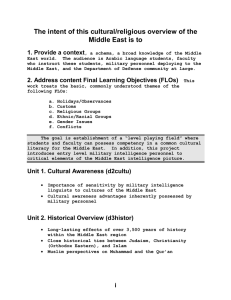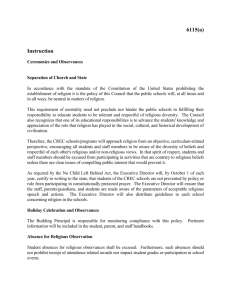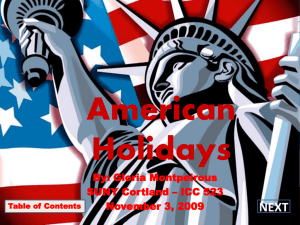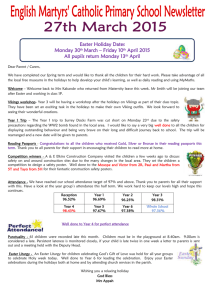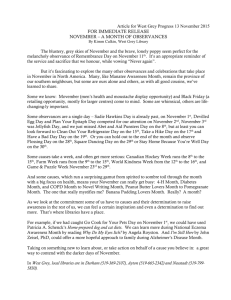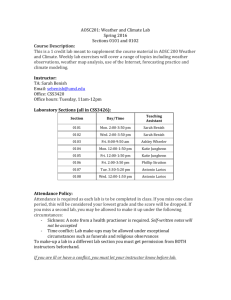Unit 6: Holidays and Observances Objectives Be aware of the following
advertisement
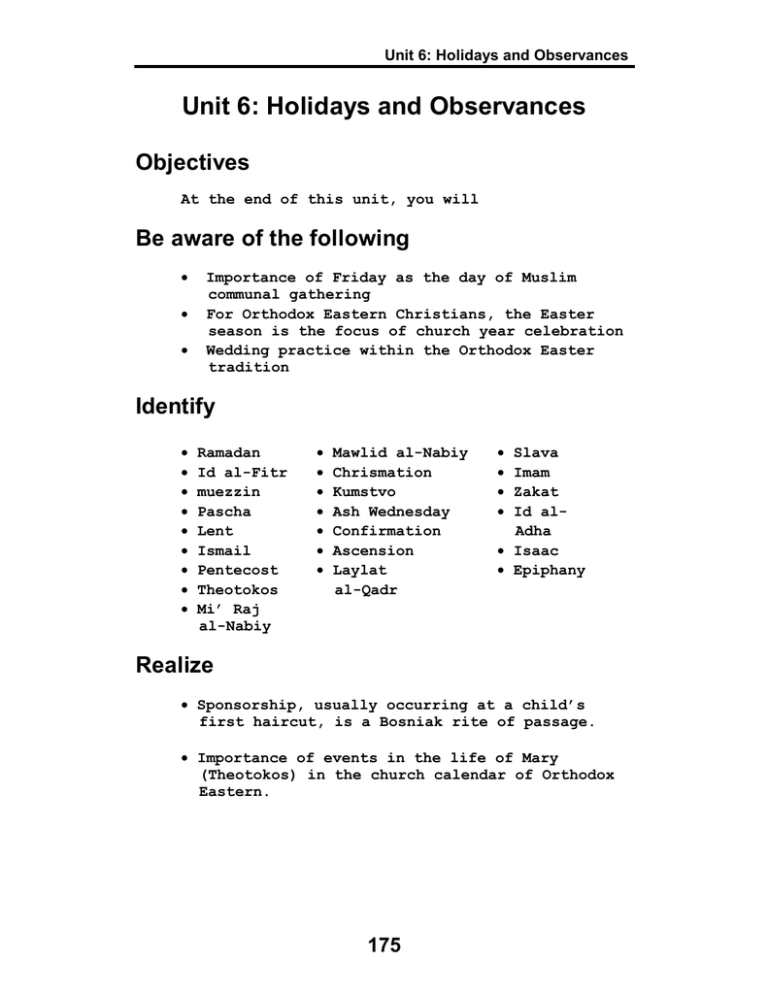
Unit 6: Holidays and Observances Unit 6: Holidays and Observances Objectives At the end of this unit, you will Be aware of the following • Importance of Friday as the day of Muslim communal gathering • For Orthodox Eastern Christians, the Easter season is the focus of church year celebration • Wedding practice within the Orthodox Easter tradition Identify • Ramadan • Id al-Fitr • muezzin • Pascha • Lent • Ismail • Pentecost • Theotokos • Mi’ Raj al-Nabiy • Mawlid al-Nabiy • Chrismation • Kumstvo • Ash Wednesday • Confirmation • Ascension • Laylat al-Qadr • Slava • Imam • Zakat • Id alAdha • Isaac • Epiphany Realize • Sponsorship, usually occurring at a child’s first haircut, is a Bosniak rite of passage. • Importance of events in the life of Mary (Theotokos) in the church calendar of Orthodox Eastern. 175 Unit 6: Holidays and Observances Unit 6: Holidays and Observances I. Muslim Festivals and Observances 1. Holy Days and Observances Within Islam, Friday is the day of communal weekly gathering. Based upon the Lunar calendar, Muslims observe the following annual festivals and holidays. a. Ramadan (RAH-mah-dahn) Ramadan is a holy month of fasting wherein Muslims, who are physically able to refrain, do not eat, drink, smoke or engage in sexual activity, from the first sign of dawn until sunset. This month is a time for spiritual reflection and discipline. Pious adherents remember past sins. They express gratitude to God for his guidance. Many read through the entire Qur’an during this month. The traditional Arabic greeting for Ramadan is “Ramadan Mubarak” (RAH-mah-dahn moo-BAR-ahk, “may God give you a blessed month”). Response is “Ramadan Karim (RAH-mah-dahn KAH-reem, “May God give you a generous month”). b. ‘Id al-Fitr (i-EED al FAHT-ehr, Festival of the Breaking of the Fast, [“Ramasan Bairam” rahm-ah-sahn bah-ee-rahm in the Serbian language]). Usually the holiday lasts for three days with family members gathering to exchange presents and celebrate together. When possible, the faithful attend mosques. It is also an occasion to pay special alms for the poor (“zakat al-fitr,” ZAH-kat al FAHT-ehr). 176 Unit 6: Holidays and Observances Traditional “Id Mubarak” (id blessed feast.” “may God make it Arabic greeting for Ramasan Bairam is moo-BAR-ahk, “may God make it a Response is “Id Karim” (id KAH-reem, a kind feast”). Along with ‘Id al-Fitr, Id al-Adha (Festival of Sacrifice) comprise the two main Islamic festivals. It comes on the first day of the month Shawwal which follows Ramadan. c. Id al-Adha (i-EED ahl-OOHD-hah, Festival of Sacrifice, [“Kurban Bairam” koor-bahn bah-ee-rahm in Serbian]. This concluding act of pilgrimage usually occurs two to three months after Ramadan. Muslims offer sheep, goats, and camels in a pattern after Abraham’s offering of his son Ismail to God. The poor and needy receive the meat. Many Muslims observe the festival whether on pilgrimage or not. Islam considers Ismail--the son of Abraham and Hagar (thus Abraham’s “firstborn”)--as the rightful heir, the son to be sacrificed. (In the Judeo-Christian tradition, Abraham’s second son [Isaac, born of Sarah] is seen to be the true heir, the son to be sacrificed]). Traditional Arabic greeting for this day is “Id Mubarak” (id moo-BAH-ahk, “may God make it a blessed feast”). d. Laylat al-Qadr (LAHAY-let al-KAHD-ehr, Night of Power) commemorates the first revelation of the Qur’an. This event came to the Prophet Muhammad in 610 C.E. (A.D.), when he was forty years old. The observance includes the last 10 days of Ramadan as no one knows the exact night the Prophet first received God’s revelation. Sometimes during this event, pious Muslims seclude themselves in a mosque, leaving only when necessary. 177 Unit 6: Holidays and Observances e. Mi’Raj al-Nabiy (mehr-raj al-NEB-bee) commemorates the ascension (al-Mi’Raj) of the Prophet to heaven following his night journey (al-Isra’) from Mecca to Jerusalem. Interpreted either symbolically or literally, the Qur’an records the event in Sura 17:1. While on this night journey, God commanded the Prophet to begin the practice of prayer five times each day. f. Nisf-Sha’ban (nush-if sha-ahBAHN, Night of Repentance) comes on the 14th day of the eighth month (Sha’ban)...in the middle (Nisf) of the month. It is a night of repentance in preparation for Ramadan. g. Mawlid al-Nabiy (MOW lid oon-NA-bee, birthday of the Prophet) is the anniversary of the birth of the Prophet Muhammad. For many Muslims, this day ranks third in importance, after ‘Id al-Fitr and Id al-Adha. h. Jum’at al-Wada’ (juhm-at al-wha-DAH, Farewell Friday) is the last Friday of the month of Ramadan. Though not a strict festival, many Muslims consider it a special day. i. Day of Hajj (al-HAHJ, Day of Arafat) comes on the ninth day of Dhul’Hihha (the month of pilgrimage). It commemorates the concluding revelation to the Prophet at Mt. Arafat, a mountain 18 kilometers east of Mecca. All Muslims on Hajj attend a service on the plains in front of Mt. Arafat (Waqfatu Arafat). 178 Unit 6: Holidays and Observances 2. Life Cycle Events a. Birth ceremony Called “akikah” (ah-KEE-kah) in Arabic, this brief, informal event welcomes a newborn infant into the home. The traditional Arabic greeting “Mabrook” (MAH-brook), meaning congratulations, is appropriate. b. Initiation rite Taking “Shahada” (SHAH-hah-dah) or “witnessing” occurs anytime from the midteens upward. It is a declaration of the Muslim faith, “There is no god but God, and Muhammad is the messenger of God.” Two male Muslims or eight female Muslims witness the event. An imam (EE-mahm) leads the prayer and gives a sermonic talk. A muezzin (MOO-ah-zin) calls the faithful to prayer. The Arabic term “mabrook” (MAHbrook) meaning congratulations, may be appropriate. c. Marriage Unless financial or physical restrictions are present, pious Muslims marry. Marriage is a social contract or covenant, not a sacrament. The ceremony, taking place in a mosque, is officiated at by an imam. Two witnesses observe the contract between the bride and groom. After the ceremony, a reception (“waleemah,” wahLEEH-mah) is common. Pious Muslims serve no alcohol at this celebration, though beverages and food abound. 179 Unit 6: Holidays and Observances Traditional Arabic greetings include “mabrook alaik” (MAH-brook ah-LAYK, congratulations) if addressing the man; “mabrook alaiki” (MAH-brook ahLAYK-ee) if speaking to the bride. d. Funeral rites Traditionally two to three days after death the funeral takes place. Calls or visits to bereaved families entail quiet sitting, offering a prayer and condolences to the bereaved family members. An imam presides at the ceremony. At the graveside, Janazah (jah-NAH-zah) prayers for the dead, are recited. The deceased is buried, never cremated. e. Kinship ties Bosniaks establish ties through sponsorship, usually occurring at a male child’s first haircut (sometime around his first-year birthday). This rite of passage may see family members choosing sponsors from outside the Muslim community, providing an occasion for healthy alliances with non-Muslim neighbors. In some extended families, the institution of godparenthood and bloodbrotherhood may be initiated at this time as well. II. Orthodox Festivals and Observances 1. Holy Days and Celebrations a. Pascha (PAS-kah) or Easter is the highlight of Orthodox calendar feasts and fasts. All other church events flow from Easter. Celebrations and observances which occur during this season include (1) Pre-lent Sundays The four Sundays before Lent offer preparation for this season. Theme of the Sundays include (a) the publican and Pharisee-humility; (b) prodigal son--return to Father; (c) meatfare Sunday--last day to eat meat until Easter (judgment); and (d) cheesefare Sunday--last day of eating eggs or dairy products until Easter (forgiveness). 180 Unit 6: Holidays and Observances (2) Lent Beginning seven weeks before Easter, this season is a time for fasting, prayer, study and worship. (3) Lazarus Saturday/Palm Sunday The day before Palm Sunday honors Lazarus, whom Jesus raised from the dead. Willows may be distributed to parishioners as part of the special service. Palm Sunday commemorates Christ’s triumphal entry into Jerusalem. (4) Holy (Passion) Week Each day of the week before Easter focuses upon the sufferings, betrayal, death and burial of Christ. (5) Easter (Holy Pascha) This midnight service invites participants to sing “Christ is risen from the dead.” An icon of Christ destroying the gates of hell may take a prominent place in the church. The date usually occurs one week after most Protestant and Roman Catholic celebrations of the Easter event. (6) Ascension 40 days after Easter, this observance commemorates the ascension of Christ into heaven. (7) Pentecost This day marks the empowering presence of the Holy Spirit upon the early church. It occurs 50 days after Easter. On the eve of Pentecost, the church remembers those who have departed this life. b. Feast Days of Christ (1) Nativity/Christmas The incarnation of God in the flesh, is Christmas. The pious faithful often precede it with a 40-day fast from meat and dairy products. The traditional greeting is “Christ is born! Glorify Him!” 181 Unit 6: Holidays and Observances (2) Epiphany (ih-PIHF-ah-nee) This celebration remembers the baptism of Jesus in the Jordan River and accompanying manifestation of his divinity when the dove descended upon him. The traditional greeting is “Christ is born! Glorify Him!” Orthodox throughout the world may also bless the waters (lakes, rivers, seas) especially where navigation takes place. (3) Meeting of the Lord (2 February) The faithful remember Christ’s presentation at the temple and meeting with Simeon and Anna on this day. (4) Transfiguration (6 August) The divinity of Christ, manifested through his glorified nature experienced on the Mount of Olives, is remembered on the transfiguration. (5) Elevation of the Cross (14 September) Some Orthodox commemorate the finding of the cross by St. Helen (4th century) with fasting on this day. c. Feast Days of the Theotokos Some Orthodox around the world remember events in the life of Mary, Jesus’ mother. (1) The nativity (8 September) remembers her birth; (2) entrance of the theotokos (21 November) recalls Mary’s presentation into the temple as a child; (3) Annunciation (25 March) commemorates Gabriels announcement to Mary that she is chosen to be the mother of Christ; (4) the Dormition (15 August) remembers her death and glorification. 182 Unit 6: Holidays and Observances d. Saint’s Days Throughout Serbian Orthodox practice, families have a specific saint who offers protection. On the celebration of the family’s saint day “slava”, large amounts of food are offered to any who come. A ritual involving a spoonful of zito (zee-to), a mush made of wheat, sugar and nuts, is also given to guests. e. Zadushnice (zah-doosh-neets-eh) Four times a year, Serbian Orthodox remember the dead by visiting their graves. 2. Life Cycle Events a. Birth Chrismation (KRIZ-may-shun, confirmation, the anointing with holy oil), baptism and first communion occur together as part of the birth ceremony ritual. A priest officiates with godparents assisting in the ceremony. Congratulations or saying “may the child live a holy life” are traditional greetings. Kumstvo (koomst-voh), the ceremony establishing godfatherhood, may also be practiced in infancy within many Serbian households. b. Marriage Serbian Orthodox marriage practice includes the following symbolic rituals, each possessing special meaning and significance. 183 Unit 6: Holidays and Observances (1) Witnesses Kumovi (koom-oh-vee) or chief witnesses serve as witnesses to the sacrament of marriage. They are like godbrother and godsister to the bride and groom. (2) Rings Blessed by the priest, the rings symbolize the complementary strengths forged through the couple’s wedding. Bride and groom exchange rings three times. (3) Candles Candles, held by the bride and groom throughout the service, symbolize the spiritual willingness of the couple to receive the blessing of Christ upon their life together. (4) Binding of hands A white cloth symbolically unites the couple together, signifying their oneness. (5) Crowning This climax of the service signifies the glory and honor with which God crowns the bride and groom. The newlywed couple becomes “king” and “queen” of their new home. The crowns may also indicate martyrdom, as every marriage involves selfsacrifice. (6) Common cup Drinking wine together from a common cup symbolizes that the couple shares everything in life--sorrows and joys, burdens and delights. (7) Ceremonial walk The priest leads the bride and groom in a circle around the table containing the Gospel and Cross. Their life together is symbolized by this orbit around the center of life-Christ himself. Sometimes a hymn is sung to the holy martyrs, remindful of the sacrificial love necessary in marriage. 184 Unit 6: Holidays and Observances (8) Blessing The priest bestows a blessing upon the couple, and ends the service. c. Funerals Priests lead a liturgy in remembrance of the dead. A traditional greeting to the bereaved includes, “May you have an abundant life” and “May their memory be eternal.” III. Roman Catholic Festivals and Observances 1. Holy Days and Celebrations a. Christmas 25 December remembers the birth of Christ. b. Ash Wednesday 40 days before Easter, this day marks the beginning of Lent. Some Roman Catholics celebrate Mardi Gras (Fat Tuesday), the day before Ash Wednesday, with a time of festivity before undergoing the rigors of the Lenten fast. c. Maundy Thursday Four days before Easter, the church gathers to follow the command to celebrate the Eucharist. Jesus’ arrest and trial are also remembered on this day. d. Good Friday The commemoration of the crucifixion, death and burial of Jesus occurs on this Friday just before Easter. e. Easter The death and resurrection of Christ surround events associated with Easter. Roman Catholics practice many of the Orthodox Church observances of the Easter season. 185 Unit 6: Holidays and Observances f. Pentecost Coming 50 days after Easter, this Sunday remembers when the Holy Spirit descended upon the early church. 2. Life Cycle Events a. Birth Ceremony The baptismal service, usually given to a six- to eight-week old infant of believing parents, incorporates the child into the church and bestows grace. It is usually a part of the larger service, the mass. b. Confirmation A baptized youth, usually between 7 and 18, is welcomed into full communion with the church through this initiation ceremony. c. Marriage The marriage service, officiated over by a priest, may be accompanied by the mass. When greeting clergy either at receptions or in the ceremony itself, tradition dictates using “father” for a priest, “your excellency” for a bishop and “Your eminence” for a cardinal. d. Funerals The priest officiates with a mass and prayers at the graveside. Among the Albanians, bodies of important men who have just died are dressed in their most typical attire. With a rifle and other artifacts (including a cigarette out of the corner of the mouth), the deceased is placed seated in his own yard. Mourners then gather to say their last goodbyes. 186 Unit 6: Holidays and Observances Vocabulary List: Holidays and Festivals Epiphany (ih-PIHF-ah-nee) Orthodox Eastern celebration remembering the baptism of Jesus and manifestation of divinity by a dove descending upon his head Hajj, Day of (al-HAHJ) Day remembering the concluding revelation of the Qur’an to the Prophet Muhammad Id al-Adha (i-EED ahl-OOHD-hah) Festival of sacrifice remembering Abraham’s offering up his son Ismail on the altar. Called “Kurban Bairam” (koor-bahn bah-ee-rahm) in Serbian. Id al-Fitr (i-EED al FAHT-ehr) Festival of the breaking of the Ramadan fast. Called “Ramasan Bairam” (rahm-ah-sahn bah-eerahm) in Serbian Imam (EE-mahm) Leader in Muslim prayers who often gives a sermonic talk Janazah (jah-NAH-zah) Prayer service for Muslims at the graveside Kumstvo (koomst-voh) Ceremony establishing godfatherhood within Serbian circles Lent Time of fasting, prayer, study and worship some seven weeks before Easter Mawlid al-Nabiy (MOW lid oon-NA-bee) Birthday of the Prophet Muhammad Mi’Raj al-Nabiy (mehr-raj al-NEB-bee) Remembers the ascension of the Prophet Muhammad to heaven following his night journey Muezzin (MOO-ah-zin) One who calls the faithful Muslims to prayer Pascha (PAS-kah) Orthodox Eastern Easter Pentecost Day marking the empowering presence of the Holy Spirit upon the early church 187 Unit 6: Holidays and Observances Ramadan (RAH-mah-dahn) Holy month of fasting for Muslims. No eating, drinking, smoking or engaging in sexual relations occurs from sun up to sun down. Slava Serbian Orthodox day of celebration for a specific saint Theotokos Orthodox Eastern term for Mary, the Mother of God Zakat (ZAH-kat) Alms taken for poorer Muslim peoples and causes “See problems as opportunities.” 188 Unit 6: Holidays and Observances Review Quiz: Holidays and Observances Part 1--Fill in the blanks Fill in the blanks with the most correct word immediately following this section. Not all words listed will be used. Among pious Muslims, (1)_______________ and (2)______________ are the two main festivals of the year. Id al- Fitr is the festival held for breaking the month long fast, or (3)_______________. Special alms taken for the poor (4)_______________ may also be taken during this celebration. Id al-Adha, the festival of (5)_______________, remembers Abraham’s offering up of his son (6)_______________ on the altar. Laylat al-Qadr, the night of (7)_______________, remembers the first revelation of the Qur’an. Mi’Raj al-Nabiy commemorates the ascension of the (8)_______________ Mohammed to heaven following his night journey. The birthday of the prophet (9)_______________ is a day ranking third in importance for many Muslims. The day of Hajj commemorates the concluding revelation to the prophet at (10)_______________. 189 Unit 6: Holidays and Observances ______________________________________________________________ Ramadan Id al-Fitr Id al-Adha prophet sacrifice zakat Mt. Arafat power Mawlid al-Nabiy Ishmael _________________________________________________________________ Within Muslim practice, an (11)_______________ leads the faithful in prayer and gives a sermonic talk. A (12)_______________ calls congregates to prayer. For Orthodox Eastern Christians (13)_______________ or Easter events are the highest of the church calendar. (14)_______________ is the time before Easter dedicated to feasting, prayer, study and worship. Coming forty days after Easter, (15)_______________ remembers Christ’s going into Heaven. (16)_______________ marks the empowering presence of the Holy Spirit upon the early church. (17)_______________ remembers the baptism of Christ and the descent of a dove upon him. Feast days of (18)_______________ remember events around the life of Mary, the mother of Jesus. For some Serbian Orthodox, (19)_______________ events celebrate family saints. Also, (20)_______________ or a godfatherhood ritual, may take place. _________________________________________________________________ Ascension Lent Muezzin Pentecost slava Epiphany kumstvo Imam Pascha Theotokos _________________________________________________________________ 190 Unit 6: Holidays and Observances Part 2--Multiple Choice Place the letter of the most correct answer in the blank provided. 1. _____ a. b. c. During Ramadan, pious Muslims fast from noon to midnight. drink only water for the entire month. do not eat, drink, smoke or engage in sexual activity from dawn to sunset. 2. _____ Another name for the breaking of the Ramadan Fast, in Serbian, is a. b. c. 3. _____ are a. b. c. 4. _____ a. b. c. kumstvo. slava. Ramasan Bairam. The two most important festivals of the Muslim calendar Mawlid al-Nabey (birthday of the Prophet) and Day of Hajj. Akikah (birth ceremony) and Nisf-Sha’ban (Night of Repentance). Id al-Adha (festival of sacrifice) and ‘Id al-Fitr (festival of breaking of the Fast). At death, Muslim faithful are always cremated. always buried. buried when convenient, cremated otherwise. 5. _____ An important Bosniak sponsorship tradition usually occurs at a male child’s a. b. c. first haircut. puberty rite. first day at school. 191 Unit 6: Holidays and Observances 6. _____ For Orthodox Eastern Christians, __________ is the highlight of the church calendar. a. b. c. Christmas Easter Pentecost 7. _____ The term __________ describes Orthodox Eastern feast days centering around the life of Mary, Jesus’ mother. a. b. c. dormition maturity Theotokos 8. _____ Orthodox Eastern faithful anoint infants with holy oil at a service of a. b. c. kumstvo. slava. chrismation. 9. _____ In the Serbian Orthodox tradition, witnesses at a wedding (kumoui) serve as a. b. c. elder parents to the bride and groom. godbrother and godsister to the bride and groom. celebrants who fire off celebratory shotguns and pistols. 10._____ Among the Roman Catholic faithful, __________ marks the beginning of the Lenten season. a. b. c. Epiphany Pentecost Ash Wednesday 192 Unit 6: Holidays and Observances Sources Used in Holidays and Observances About Being Orthodox. South Deerfield, MA: Channing L. Bete, 1996. Bennett, Linda (Volume Editor). Encyclopedia of World Cultures, Vol IV, Europe. New York: G.K. Hall, 1994. Magida, Arthur J. How to Be a Perfect Stranger. Vermont: Jewish Lights, 1996. Woodstock, Smith, Jonathan, ed. The HarperCollins Dictionary of Religion. New York: HarperCollins, 1995. Smith, Martha Cosgriff and Harry Martin. Matrimony.” 12 February 1983. “The Sacrament of Holy Spence, David. The Multifaith Calendar. Burnaby, British Columbia: Hemlock Printers, 1996. Thompson, Sue Ellen and Barbara Carlson, eds. Holidays, Festivals and Celebrations of the World Dictionary. Detroit: Omnigraphics, 1994. “I truly believe that the ultimate determinant in the struggles that we will face will not be tanks and airplanes, but a test of wills and national character...a trial of spiritual resolve...the values we hold...the beliefs we cherish...the ideals to which we are dedicated. These intangibles are America’s strength.” General Charles Krulak 193 Unit 6: Holidays and Observances 194
